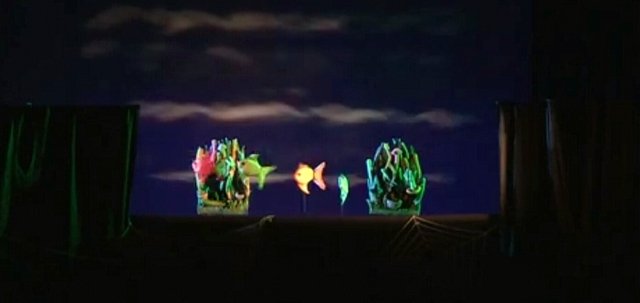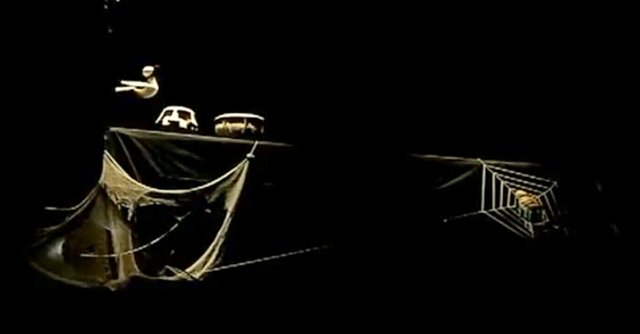Sergey Vladimirovich Obraztsov is considered to be the exponential spearhead of the modern puppeteering renaissance in Moscow in the 1920s and 30s. In his illustrious career which spanned up until the 1990s, Obraztsov earned such a fame that the Moscow State Puppet Theatre had to be renamed Obraztsov Puppet Theatre after he breathed his last. My childhood as a puppet-trainee under Mr Swapan Roy was spent turning over the pages of his seminal book My Profession. I grew up hearing the names of Michael Meschke, Josef Skupa, Jiří Trnka, Nikolai Zykov, Tamao Yoshida and the like. Obraztsov made the unprecedented fusion possible: not only was he establishing puppetry as a posh art form, he was also evolving a modern fine art trend in the flow of traditional puppetry. The narratology of puppetry secured a central niche in his hands. Puppetry also found its expression as a mixed art form of all “mixed performing art forms” under his wings.
Sudip Gupta has been walking alongside the colossal giants of contemporary puppetry since the 1990s: Suresh Dutta, Dadi Pudumjee, Meher Contractor, Michael Meschke, Sanjit Ghose to name a few. If you happen to experience Hiren Bhattacharya’s Khude Potuar Rupkatha (The Saga of the Little Painter), you will be transformed into a visionscape in which anything can happen at any given moment. It is a journey from one awakening surprise to the next. If you happen to watch Suresh Dutta’s Aladdin, from time to time you may feel nauseating moments of hallucinogenic surprise—the kind of “stock amazement” big screen VFX still cannot deliver to this day. Gupta has taken the mould of Bhattacharya and Dutta’s narratology and has coloured it with his fine art skills. Sudip Gupta’s is a bridge between not only the traditional and the cultivated contemporary but that of abstract objective expressionism and operatic symphony.
I have been waiting for at least seventeen odd years to experience Sudip Gupta’s workmanship. The artistry was worth the wait. It comes to me as no surprise that he has been visiting the prestigious International Puppet Theatre Festivals in Tehran, Israel, Spain. The storytelling in Indian contemporary puppet theatre has broken away from anthropocentric dramatization to environmental abstract in his skilful peerless hands. I do not think a written review of his work can possibly do justice to his teamwork, his spectacular operatic tenor and the time-sensitive manipulation of his deft puppeteers.
His “The Taming of the Wild” reads Shakespeare, but looks expressionistic and sounds so very Indian to its core. The quartet opens with the fishes and the angling hook’s skit, which in itself is an exemplary instance of stage lighting in puppetry. Creating the illusion of an underwater aquatic world with only lights thrown in the background is a theatrical treat. His puppetry is predominantly rod puppeteering in its form but is quite objective expressionistic in its range and feel. Yes, the marine utopia-under-human-invasion could use a few bubbles, the underwater plants could be a little mobile/twisting and turning, and the music could be more sombre but then our eyes are smeared/soiled by both Finding Nemo and Finding Dory. Dolls Theatre’s work is more like reading a book in the era of fast-cutting action movie scenes. The first marine skit has a lulling expressionism to it. Not only did it question the vexed issues of overfishing in the age of climate change but it also gave us a little time to think and reflect. How do the fishes feel? Do they also have a sense of loss? Are they also driven by the Mahabharatian idea of revenge? Is “physical humour” in puppetry still possible without “human characters” in rod puppet stage?
Not to give away more about the snippets, the next performance is about the survival of a plant/tree. It was a masterpiece of what I am trying to designate as “abstract objective expressionism” in Gupta’s plays. The man is a generic metaphor for all those people who are absolutely/intentionally unaware of the encroaching menace called climate change. Deforestation and industrialization are both portrayed metaphorically by the axe and the smoke-breathing roller engine respectively in the play. The only man-puppet in “The Taming of the Wild” is an epitome of “objective abstraction”. The skit is punctuated with laughter-provoking satirical brushwork which fantastically culminates in a celebration of green in the end. The ending shows you “green colours splashing all over the stage canvas”—a culmination of Gupta’s expressionism. He made it possible just by manipulating only two sticks with green light cloths on them. His minimalism not only carries a message for us in the face of environmental colonialism but also brings awe in our colour-splashed, music-drenched eyes. If the plant shows fluidity of movement with the growing butterfly and birds, it turns stone cold and unable to be felled in the presence of the logger. Mother Nature here hardly responds to the creeping harshness of human hunger. Sudip Gupta shows how “Mother” in the Nature is not “always forgiving/complacent/feminine/reticent/convenient an entity” which will endure every fingerprint and carbon footprint that we calously plant in it, rather “Mother” nature here nurtures the non-human kingdom that understands its place of symbiotic loving relationship.
The third part had a spider, spider web, tabla, a cello, a musician feather and a pair of birds in it. Sudip Gupta innovatively transforms his rod puppet stage into a two-tier canvas for his part. The spider and the spider-web operate on the lower tier while the orchestra of the birds and the cello play on the upper tier stage. The skit underlines the fact that not only do “the birds and insects respond to music” but they also possess their very own synergy of creating music. With matchless puppeteering they manipulate the birds according to the pre-recorded tabla strokes. Timing is crucial in his skit. So are the music beat clues. If the first half of this skit had a dearth of symphony, the second half (with an egg breaking and birthing of a baby bird) was flooded with orchestration. Music in Sudip Gupta’s hands is no more a human-centric phenomenon alone, music breaks the walls of the dichotomy between the human and the non-human in this matchless musical.
“The Taming of the Wild” closes with a Black Light-driven muppet opera. The final sketch by Dolls Theatre is a feast to your eyes. I have seen my dad, in one of his coal mining-plays, create the illusion of water logging in a darkness-caked coal mine with the help of thin plastic sheet, but Dolls Theatre trumps the swelling of ocean waves. The puppet stage, now a theatrical ground floor stage, is rather an impressionist canvas in which (because of the employment of Black Light) light is chasing darkness and darkness the light. Pelicans roam the canvas: they call out, they fly, they jump, they get entangled in the nets of a muppet/human with painted smeared palms on his garb. Palms symbolise the colonial aggression of the human-centric poaching and fishing in Sudip Gupta’s world. One should also note that the logger who wanted to cut down the tree in the second sketch had an axe resembling a palm in it. Human grasp is not an abstract notion to Gupta. It is very much a looming, menacing impactful icon to Sudip Gupta. I have seen the employment of Black Light when I was in my high school: in my dad’s version of Manoj Mitra’s Sajano Bagan, which showed the Bramhodaitya sweeping upward and perch on the branch of “his” tree. Here Sudip Gupta fills his stage canvas with operatic music, fluorescent expressionism and the effet de soir of sweeping impressionism punctuated with the sounds of the waves dashing against shore and the sound of the sea gulls.
Before we conclude, sitting at a theatrical show was pretty painful for me. It was a rollercoaster of rumination: I lost my dad nine years ago and with him I parted from the hallowed road of theatre culture in my life. As the rest of the family enjoyed Sudip Gupta’s adept canvas of fine art and musical synergy, I was bubbled over with nostalgia, memory and grief. It may be an “experience” to you, but it was a “walk down the memory lane” for me, overshadowed by my dad. Interestingly, it was my late dad who first told me about Sudip Gupta’s puppet sketches.
Image Courtesy: SPIC MACAY International Convention, Kolkata Chapter, 2013 and Harmony World Puppet Carnival, Thailand, 2014






